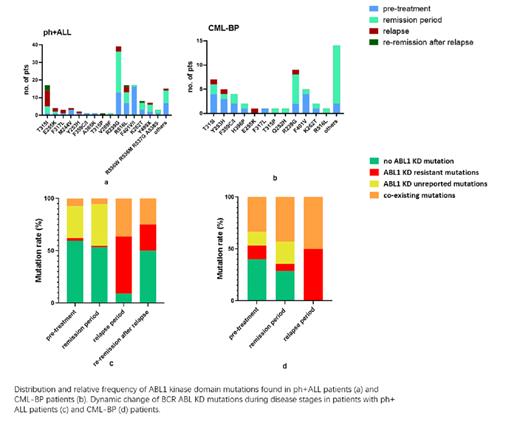*Drs.Zixuan Li and Danyue Peng contributed equally. Drs.Mei Hong and Qiuling Wu are co-corresponding authors
Background
The development of first-generation and second-generation tyrosine kinase inhibitors (TKIs) has played a crucial role in the treatment of Philadelphia-positive acute lymphoblastic leukemia (Ph+ ALL) and chronic myeloid leukemia (CML). However, the emergence of mutations in the kinase domain (KD) of BCR-ABL1 has increasingly compromised the efficacy of TKIs and become the primary cause of TKI resistance. Testing BCR-ABL1 KD mutations in early phase accurately is of great value in predicting response and guiding therapeutic decisions. Next-generation sequencing (NGS) provided a more comprehensive and elaborate understanding of mutation status. Third-generation (3G) TKI has been designed to overcome resistance problems caused by BCR-ABL1 KD mutations, and it exhibited unique pharmacological profiles and response patterns relative to different mutations and disease characteristics. Therefore, the potential clinical relevance of mutations detected by NGS and the efficacy of 3G TKI are worth exploring.
Methods
NGS was used to analyze the dynamic changes of both clinically unreported mutations and reported resistant mutations in the ABL1 KD during three stages of the disease course (pretreatment, remission, and relapsed periods) in Ph+ ALL (n = 97) and chronic myeloid leukemia blast crisis (CML-BP) (n = 21) patients. Meanwhile, the comparative efficacy of three generations of TKIs in Ph+ ALL (n = 92) and CML-BP (n = 23) and the relationship between ABL1 KD mutations and different TKI selection were analyzed.
Results
In Ph+ ALL patients, single ABL1 KD unreported mutations were detected in 30.49% of patients before therapy and 39.73% in remission, which accounted for the highest proportion among other mutation types. Conversely, single ABL1 KD resistant mutations were found to be the most prevalent (54.5%) in relapsed patients ( P < 0.0001). Logistic analysis revealed that the presence of F401V/L in untreated Ph+ ALL patients was associated with a higher risk of relapse ( P < 0.1). Furthermore, through analyzing patients who received TKI treatment, we observed that 3G TKIs like olverembatinib exhibited advantages in prognosis, including achieving deep molecular response, rapid remission reduction, and decreased relapse probability, for both newly diagnosed and relapsed Ph+ ALL patients. Notably, 3G TKIs not only demonstrated strong inhibition against the T315I mutation, as previously reported, but also displayed superior effectiveness against certain ABL1 KD unreported mutations, such as R516L, K262T, and F401V. Similar trends were observed in CML-BP, although statistical significance was not reached likely due to the limited number of patients.
Conclusion
Overall, our findings indicate the prevalence and impact of ABL1 KD mutations in Ph+ ALL and CML-BP patients, highlighting the necessity for effective therapies targeting these mutations. The promising outcomes observed with 3G TKIs suggest their potential as a treatment option for both newly diagnosed and relapsed Ph+ ALL patients, offering advantages in terms of molecular response depth, rapid remission, and reduced relapse risk. Further investigations are warranted to explore the clinical significance of unreported ABL1 KD mutations and validate the effectiveness of 3G TKIs against them.
Disclosures
No relevant conflicts of interest to declare.


This feature is available to Subscribers Only
Sign In or Create an Account Close Modal